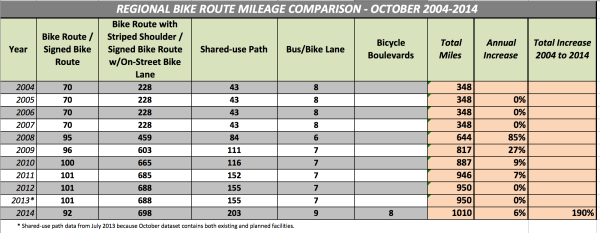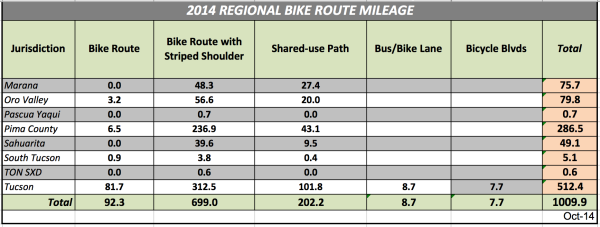
Cyclists around the region have thousands of options when they throw their leg over a bike. Literally.
An analysis by the Pima Association of Governments shows the region, which includes Marana, Pascua Yaqui Nation, Pima County, Sahuarita Tohono O’odam Nation and the City of Tucson, has more than 1,000 miles of bike infrastructure in the region.
The 1,009 total miles includes, bike routes, bike routes with striped shoulders, shared-use paths, bus/bike lanes and bicycle boulevards and is an increase of 190 percent since 2004.
For Ann Chanecka, the City of Tucson’s bicycle and pedestrian program manager 1,000 miles is important because each new mile of infrastructure is a way to encourage someone new to ride a bike.
“Every time we add a mile it adds a possibility to get someone out on a bike,” she said.
PAG’s Gabe Thum coordinates the group that puts the numbers together and said keeping track of the number of miles in the region is important.
“We are a bicycling town and we value bicycling, he said. The old adage, ‘you value what you measure and you measure what you value’ holds true. It gives us an overall general yardstick of how we are doing. ”
Thum said they finished the newest count in October and the 1,000 miles are counted by linear mile, meaning a mile long stretch of road with a striped shoulder on both sides only counts for 1 mile instead of two miles.
“We aren’t trying to double dip.” he said.
Matt Zoll, Pima County’s bicycle and pedestrian program manager and said it’s great to cross 1,000 miles, but there is more work to do.
“We always desire more, but we have it pretty good compared to other places,” Zoll said.
“It shows a huge commitment in the region to cycling that goes back a long time,” Chanecka said. “Now we have to look at how to have a complete network overall. We’re not done. We have more to do.


Hmmm…..I have a problem with counting striped shoulders as a part of bicycle infrastructure. Where the shoulders have been widened to the right of the white line during new or reconstruction, OK, maybe. But moving or painting a line a few feet from the edge of a roadway is not giving cyclists anything thing they didn’t have before nor does it mean that particular cycling needs have been addressed. Government folks will do what they will, but it is disingenuous to lump a good portion of the striped shoulders in this area into a category that implies meaningful effort has been made to improve or even meet cycling standards.
@zz I disagree. I think that the striping (new paint, and also moving paint to make a wider striped shoulder or non-technical “bike lane” has dramatically improved connectivity and my perception of cycling safety in Tucson.
Yes, it is inexpensive, and yes, it is easy. But what it has also done is to make a visual space for cyclists in the region, and I really appreciate that.
Why not paint all 10,000 miles or whatever it is of roadway in Tucson with white stripes and declare Tucson the forever “winner” of bicycle infrastructure? Stronger than the Universe! Indeed, many in media would fall for the claim.
Meanwhile the ridiculous trio could continue to ignore potholes in neighborhood streets, reaching out to outlying neighborhoods, safe connections to Suntran, things like that…
@bike geography Striped shoulders don’t open streets to bicycles and therefore don’t affect connectivity. The streets are there and bikes are allowed on them. I’ve always thought that the lines are more for the cars than the bikes so that drivers can see that space and be alert(?) that something could be in it. Bikes can use the whole lane if need be and cars can use the shoulders, striped or not and that’s not bike infrastructure. To claim that it is. is indeed boasting and puffery. The condition of a lot of striped shoulders would not attract new riders any more than a lane full of tacks.
Visual space?…..could actually be considered a detriment if drivers , as many do, infer that cyclists are not permitted left of the white line and if we want three feet, we had better be hugging the curb.
It really concerns me that the city is comfortable with urging newbie riders out on these streets with this bragging intended to raise the perception of safety.
We don’t need more miles of bicycle infrastructure. We need the infrastructure that already “exists” to be higher quality. No potholes please, trimmed weeds so visibility is not impaired. Roadways that don’t require one to use loctite, or every nut to be one with a nylon insert so that they (usually) stay on the bike. Streets that are swept after a rainstorm that leaves loose gravel at every intersection.
Agree with ZZ. On Campbell just north of Sixth Street, for instance, the stripe is 19 inches from the curb. PAG is free to call this “infrastructure” if it likes, but it does nothing to increase bicyclist safety and is a strong visual cue to motorists that if they stay one micron to the left of the line, they have fulfilled their duty to overtake safely.
Boasting? I wouldn’t be boasting. It is a testament to the extreme automobile centric sprawling place that is Tucson. Makes me wanna cry. We have so many roads, we cannot maintain them properly. Quantity over quality seems to be the theme around here. What a shame.